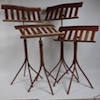hi:
Assuming the photo I tried to attach is attached.. (The color is "enhanced" to show contrast).
This is a piece of jatoba just cut on a table saw (I don't have a band saw).. There are no marks on the exterior, and there's nothing wrong with the
saw blade. I cut about 40 feet after this, and this is the only example.
The deepest and longest one is about 1/16th deep, but two of the shorter ones appear to match up on opposite sides of the saw blade - 1/8th thick.
But...? what are these? Anyone know?
More importantly, this wood is supposedly kiln dried and has been in storage for at least six months. Is there any risk I'm bring live worms (or whatever) into the house with it?




 Reply With Quote
Reply With Quote




 )
)
